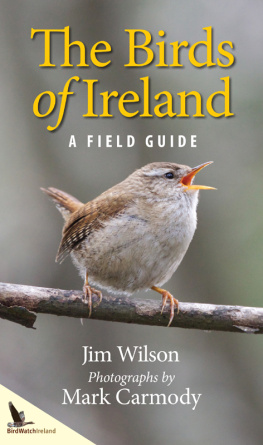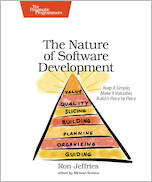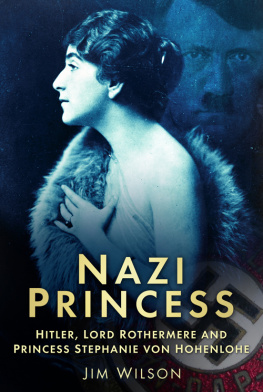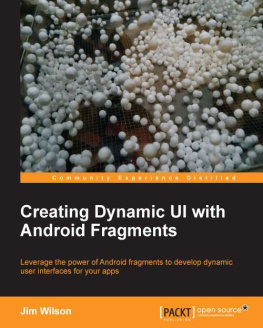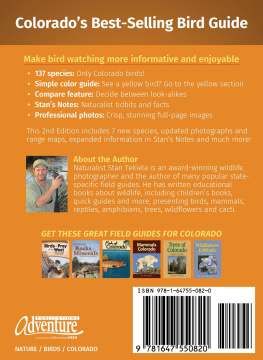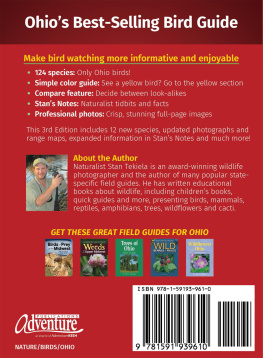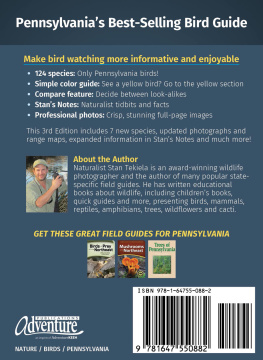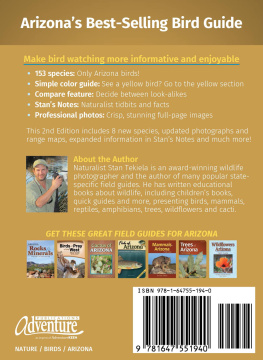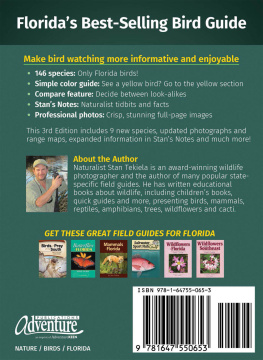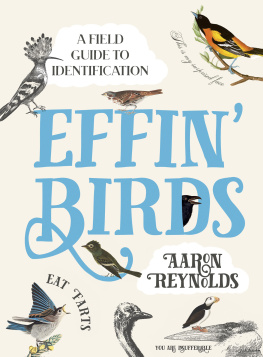Jim Wilson - Birds of Ireland : a field guide
Here you can read online Jim Wilson - Birds of Ireland : a field guide full text of the book (entire story) in english for free. Download pdf and epub, get meaning, cover and reviews about this ebook. year: 2013, genre: Home and family. Description of the work, (preface) as well as reviews are available. Best literature library LitArk.com created for fans of good reading and offers a wide selection of genres:
Romance novel
Science fiction
Adventure
Detective
Science
History
Home and family
Prose
Art
Politics
Computer
Non-fiction
Religion
Business
Children
Humor
Choose a favorite category and find really read worthwhile books. Enjoy immersion in the world of imagination, feel the emotions of the characters or learn something new for yourself, make an fascinating discovery.
- Book:Birds of Ireland : a field guide
- Author:
- Genre:
- Year:2013
- Rating:4 / 5
- Favourites:Add to favourites
- Your mark:
- 80
- 1
- 2
- 3
- 4
- 5
Birds of Ireland : a field guide: summary, description and annotation
We offer to read an annotation, description, summary or preface (depends on what the author of the book "Birds of Ireland : a field guide" wrote himself). If you haven't found the necessary information about the book — write in the comments, we will try to find it.
Birds of Ireland : a field guide — read online for free the complete book (whole text) full work
Below is the text of the book, divided by pages. System saving the place of the last page read, allows you to conveniently read the book "Birds of Ireland : a field guide" online for free, without having to search again every time where you left off. Put a bookmark, and you can go to the page where you finished reading at any time.
Font size:
Interval:
Bookmark:






in association with BirdWatch Ireland
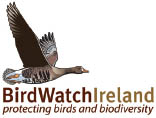
Jim Wilson, wildlife writer, broadcaster, tour guide, and former chairman of BirdWatch Ireland, co-wrote Irelands Garden Birds (2008), Shorebirds of Ireland (2009), and Freshwater Birds of Ireland (2011). He has been involved in the study and conservation of birds in Ireland for over 35 years, contributing to major surveys and international projects.
www.irishwildlife.net
Mark Carmody previously worked as a postdoctoral researcher in genetics following his PhD. He now works as a qualified Patent Attorney. Co-author of Shorebirds of Ireland and Freshwater Birds of Ireland, and a regular contributor to Wings, he has had photographs published in the renowned Birding World, and is an editor of the Cork Bird Report. A member of BirdWatch Ireland, Mark has also contributed to surveys and international projects concerning wildlife and the environment.
www.markcarmodyphotography.com
www.flickr.com/photos/drcarmo
Follow Mark on Twitter at @MarkCPhotografy
This book is dedicated to three people whose lives and inspiration made this guide a reality. To our mother and grandmother Nodlaig Wilson (19222012). To amon de Buitlar (19302013) and Oscar Merne (19432013).
As always, I would like to thank Ann, Barry and Peter for putting up with me and being a great help and support and giving me the space and time to write this guide. A very special thanks to Margaret, Carmel, John and Mary for their support in so many ways, especially over the last twelve months.
Jim Wilson
I would like to thank Mary, John, Gillian, Paul, Sandro, Elia and Jasper for having the patience and understanding as I travelled across Ireland taking photographs at weekends instead of visiting them all in Cobh. I hope the book finds good use in your respective homes and beyond!
Mark Carmody
Jim and Mark would like to thank everyone who helped us along the way and the following people for their invaluable support, help and advice in the writing of this book: Alan Lauder, Niall Hatch and all at BirdWatch Ireland, Joey Campbell, Shay Connolly, Aoife Dorney, Des Fay, Joe Hobbs, Niall T. Keogh, Paul Moore, Killian Mullarney, Barry ODonoghue, Michael John OMahony, Glen McArdle, Rnn McLaughlin, Pete Potts and Pat Smiddy.
We would both like to especially thank all at The Collins Press without whom this book would not be possible.
Mark Carmody took almost all the photos in this guide. We would like to thank the following photographers who helped us to fill the gaps and who generously contributed the following images. These photographers have gone to great lengths to take these photographs and they retain full copyright to those here in this guide and cannot be used elsewhere without prior permission from the photographer: Numbers in brackets after the species name below indicate the image in question, located by counting the images on the plate from left to right and top to bottom. Flock shots are counted as one image. The age/sex of the bird will be included here for clarity if needed.
Dave Appleton (.

A male Chaffinch
To some, birdwatching might, on the surface, look like a strange pastime involving a few people dressed in camouflage jackets running around the countryside looking for some small brown birds. But birdwatching is a lot more than that. We are all birdwatchers to a greater or lesser degree. At some stage or other each of us has had our attention drawn to a wild bird, whether looking at a cheeky Robin in the garden, watching seagulls during a day at the beach in summer or when feeding the swans at the local pond.
Birdwatching can become a lifetime hobby. Its beauty is that birds are everywhere, from the windowsill in the centre of a town or city to the cliff tops of the most remote, windswept island. So you can birdwatch anywhere, any time, and anyone can do it, no matter what their age, sex or physical ability. Even if you are confined to home, to bed, or to a wheelchair, you are in business as long as you have even the most limited window to the outside world. Once you are bitten by the bug (or bird!), there is no limit to the level of enjoyment and knowledge to be gained from studying even one bird species. Whole books, for instance, have been written about the Robin alone. Through birdwatching you can also get involved in practical conservation work by taking part in national and international surveys. You can make a valuable contribution to our knowledge and the conservation of birds.
Birdwatching is also one of the best introductions, both for young and old, to the natural world around us. You may find that your attention will be drawn to the flowers and plants which birds use, or to the multitude of creatures, big and small, on which they prey. Most good birdwatchers are also very knowledgeable about plants, animals, butterflies and moths, and even weather forecasting. Many of the most famous naturalists began as birdwatchers.
Note: In recent years the terms birding instead of birdwatching and birder instead of birdwatcher have become popular amongst many experienced birdwatchers in Ireland. The authors prefer the terms birdwatching and birdwatcher and these will be used throughout this guide.
Bird identification is basically an exercise in observation. It makes you examine more closely everything you see and hear. With practice you will learn to gather a lot of information in a short space of time about the birds you find. Sometimes it can be very easy, as some birds such as the Magpie have very obvious features that are unique to them. Other times, for the differentiation of birds that look very similar, such as the Willow Warbler and Chiffchaff, it is a bit like those spot the difference puzzles where two images are presented that look identical but have very subtle differences, and you have to look carefully to see them. Even if you can identify only a dozen different birds, by looking at them and memorising what they look like, you will notice that there is something different about any new bird which appears. The topics discussed in this chapter will help you on your way to becoming a confident birdwatcher with the ability to identify birds you see and help you get more enjoyment from your hobby.

A Willow Warbler and a Chiffchaff a difficult identification challenge.
Next pageFont size:
Interval:
Bookmark:
Similar books «Birds of Ireland : a field guide»
Look at similar books to Birds of Ireland : a field guide. We have selected literature similar in name and meaning in the hope of providing readers with more options to find new, interesting, not yet read works.
Discussion, reviews of the book Birds of Ireland : a field guide and just readers' own opinions. Leave your comments, write what you think about the work, its meaning or the main characters. Specify what exactly you liked and what you didn't like, and why you think so.

